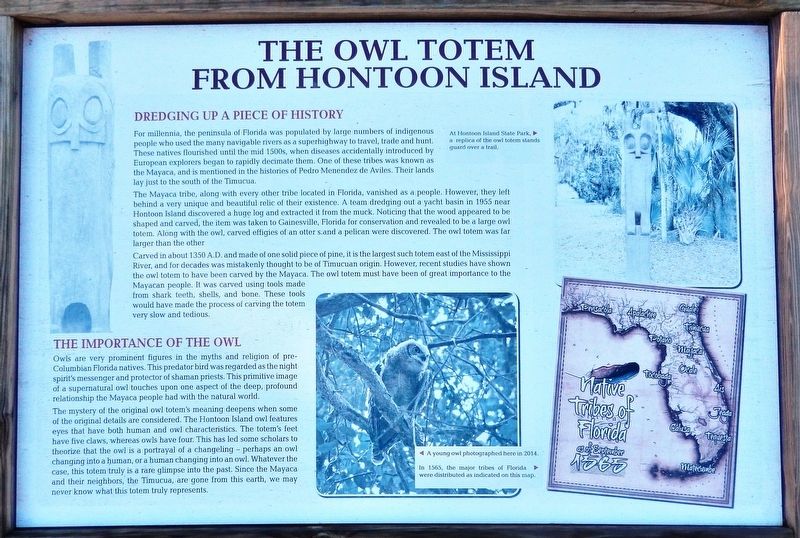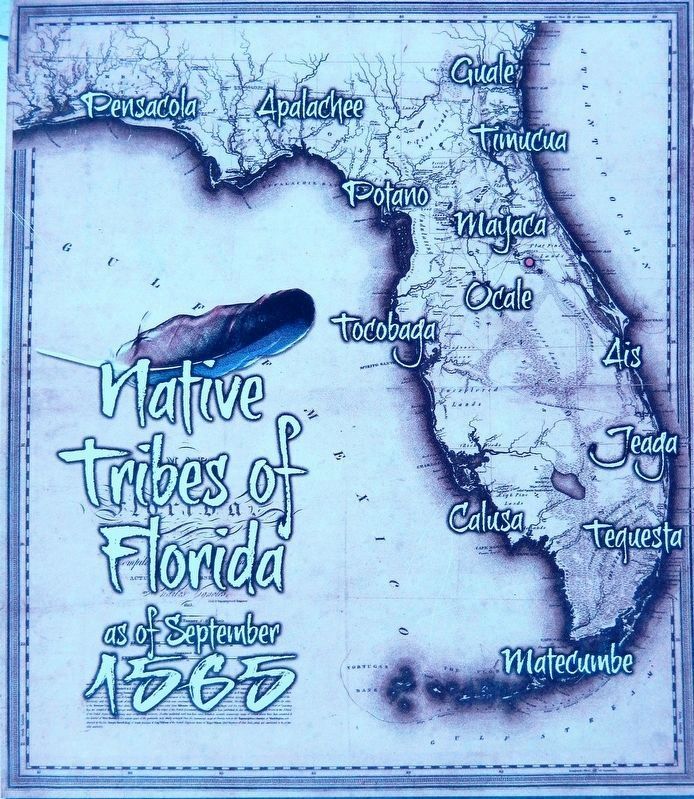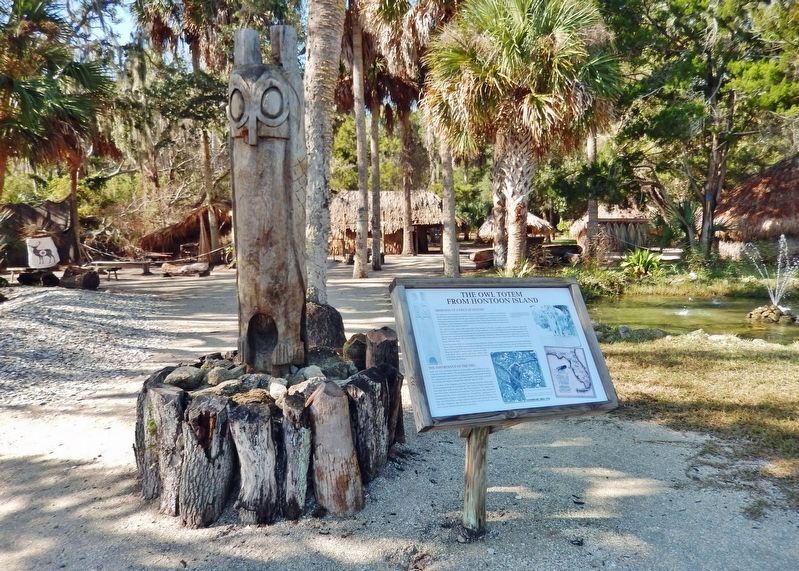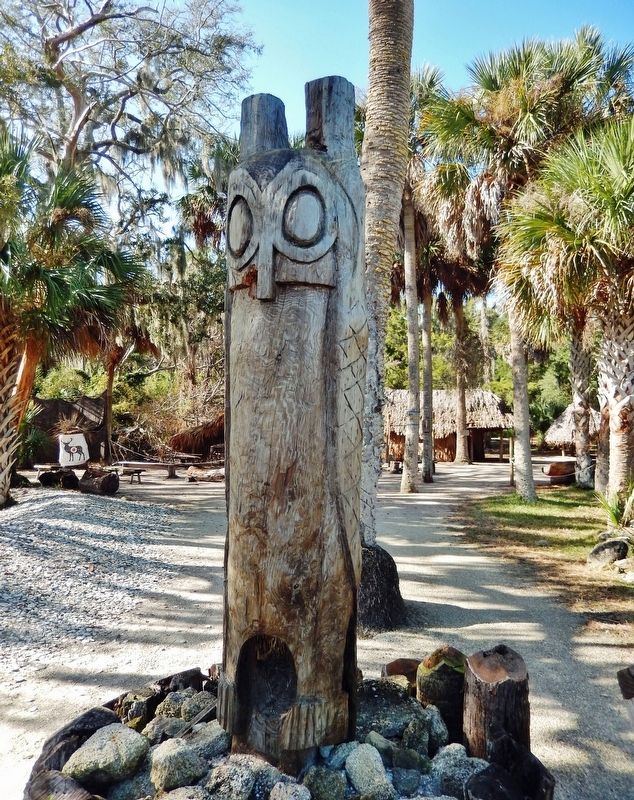St. Augustine in St. Johns County, Florida — The American South (South Atlantic)
The Owl Totem from Hontoon Island
Dredging up a Piece of History
For millennia, the peninsula of Florida was populated by large numbers of indigenous people who used the many navigable rivers as a superhighway to travel, trade and hunt. These natives flourished until the mid 1500s, when diseases accidentally introduced by European explorers began to rapidly decimate them. One of these tribes was known as the Mayaca, and is mentioned in the histories of Pedro Menendez de Aviles. Their lands lay just to the south of the Timucua.
The Mayaca tribe, along with every other tribe located in Florida, vanished as a people. However, they left behind a very unique and beautiful relic of their existence. A team dredging out a yacht basin in 1955 near Hontoon Island discovered a huge log and extracted it from the muck. Noticing that the wood appeared to be shaped and carved, the item was taken to Gainesville, Florida for conservation and revealed to be a large owl totem. Along with the owl, carved effigies of an otter and a pelican were discovered. The owl totem was far larger than the others.
Carved in about 1350 A.D. and made of one solid piece of pine, it is the largest such totem east of the Mississippi River, and for decades was mistakenly thought to be of Timucuan origin. However, recent studies have shown the owl totem to have been carved by the Mayaca. The owl totem must have been of great importance to the Mayacan people. It was carved using tools made from shark teeth, shells, and bone. These tools would have made the process of carving the totem very slow and tedious.
The Importance of the Owl
Owls are very prominent figures in the myths and religion of pre-Columbian Florida natives. This predator bird was regarded as the night spirit's messenger and protector of shaman priests. This primitive image of a supernatural owl touches upon one aspect of the deep, profound relationship the Mayaca people had with the natural world.
The mystery of the original owl totem's meaning deepens when some of the original details are considered. The Hontoon Island owl features eyes that have both human and owl characteristics. The totem's feet have five claws, whereas owls have four. This has led some scholars to theorize that the owl is a portrayal of a changeling — perhaps an owl changing into a human, or a human changing into an owl. Whatever the case, this totem truly is a rare glimpse into the past. Since the Mayaca and their neighbors, the Timucua, are gone from this earth, we may never know what this totem truly represents.
[photo captions]
• At Hontoon Island State Park, a replica of the owl totem stands guard over a trail.
• A young owl photographed here in 2014.
Topics. This historical marker is listed in these topic lists: Anthropology & Archaeology • Colonial Era • Exploration • Native Americans.
Location. 29° 54.396′ N, 81° 18.891′ W. Marker is in St. Augustine, Florida, in St. Johns County. Marker can be reached from Williams Street east of Magnolia Avenue. Marker is located along the interpretive trail in Ponce de León's Fountain of Youth Archaeological Park. Touch for map. Marker is at or near this postal address: 11 Magnolia Avenue, Saint Augustine FL 32084, United States of America. Touch for directions.
Other nearby markers. At least 8 other markers are within walking distance of this marker. The Menéndez Settlement Field (within shouting distance of this marker); Archaeology of the Menéndez Encampment (within shouting distance of this marker); The Timucuan Home (within shouting distance of this marker); The Original Mission Church (within shouting distance of this marker); Life in the Timucuan Village (within shouting distance of this marker); Mission Life in Nombre de Dios (within shouting distance of this marker); Timucuan Style Dugout Canoe (within shouting distance of this marker); 1770s British Anchor (within shouting distance of this marker). Touch for a list and map of all markers in St. Augustine.
Related markers. Click here for
a list of markers that are related to this marker. Ponce de León's Fountain of Youth Archaeological Park
Also see . . .
1. The only ancient owl carving found east of the Mississippi.
Victor Roepke, who owned a mile stretch of land on St. Johns, was dragging the river in 1955 when he stumbled on the totem. The 10-foot owl, carved from a single piece of southern hard pine. It once guarded the shore of the 1,600-acre island, which is now a state park. Hontoon Island has a long history of indigenous habitation going back thousands of years. The owl totem’s original purpose is unknown, but there are several theories. Some plausible explanations claim it’s a clan emblem, religious object, or territorial boundary marker.(Submitted on December 29, 2021, by Cosmos Mariner of Cape Canaveral, Florida.)
2. Finding the Meaning of the Owl Totem.
Research shows that the Mayaca people lived in what would become Central Florida for more than 12,000 years before Spanish explorers encountered them in the 16th century. Hontoon Island’s location along the St. Johns River ensured a plentiful supply of fish, shellfish and other marine creatures, making the area a desirable place to live. It is thought that the totem was displayed as a territorial marker, indicating the area belonging to the Mayaca. Some researchers think the owl totem had spiritual significance and was used as a means of protection. As a territorial marker, it tells us that the Mayaca people claimed this area as their home. They likely took great pride in living here and protecting the land from outsiders.(Submitted on December 29, 2021, by Cosmos Mariner of Cape Canaveral, Florida.)
Credits. This page was last revised on December 29, 2021. It was originally submitted on December 28, 2021, by Cosmos Mariner of Cape Canaveral, Florida. This page has been viewed 522 times since then and 95 times this year. Photos: 1, 2, 3, 4. submitted on December 29, 2021, by Cosmos Mariner of Cape Canaveral, Florida.



